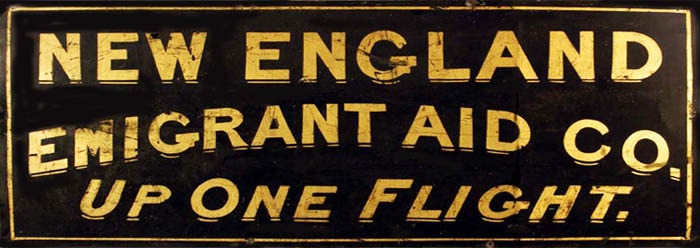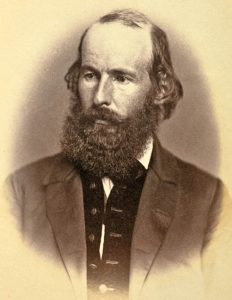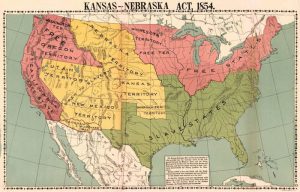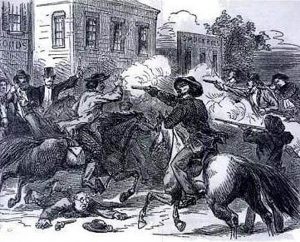While the Kansas-Nebraska Bill was pending in Congress, it became apparent that there would be a struggle between the pro-slavery and abolitionists for the Territory of Kansas as soon as it was organized. Before the bill even became law, several aid societies and cooperative associations were formed in the North to populate Kansas with those who opposed slavery. Some of these societies were incorporated under the laws of different New England states, some were private companies, and some were of local significance — formed in a town or county — but all had the same objective.
Eli Thayer, a member of the Massachusetts House of Representatives, evolved the plan of a society that should offer anti-slavery emigrants inducements sufficient to offset the hardships of frontier life. His strategy was for an investment company to give advantages to those whom it induced to go to Kansas and, at the same time, defeat slavery.
Thayer presented to the Massachusetts House of Representatives in March 1854 a petition to incorporate the “Massachusetts Emigrant Aid Company.” On April 26, 1854, more than a month before the passage of the Kansas-Nebraska Bill, this company was chartered with a capital of $5,000,000.
The incorporators selected a committee consisting of Eli Thayer, Alexander H. Bullock, and Edward Everett Hale to recommend a system of operation. The first charter was proving unsatisfactory; the company reorganized under a charter granted by the Connecticut legislature. A third charter was obtained in 1855 when the name was changed to the “New England Emigrant Aid Company,” with a capital of $1,000,000. The work done by this society, directly and indirectly, was one of the most significant factors in making Kansas a Free-State. Agitation of the question, advertisements in the papers, and the literature distributed started many for Kansas, who never knew of the country until this work commenced.
The company’s agents were Charles Robinson, Samuel C. Pomeroy, and Martin F. Conway. They secured low transportation rates to the territory, and the first emigrants, 30 in number, led by Charles H. Branscomb, arrived at the mouth of the Kansas River on July 28, 1854. Two weeks later, they were followed by a second and larger party, and these men laid the foundations of Lawrence, the first Free-State settlement in Kansas.
“The Emigrant Aid Company of New York and Connecticut” was organized on July 18, 1854, under a charter from the Connecticut legislature, its objects being the same as those of the New England society, with which it was ultimately consolidated, with John Carter Brown of Providence, Rhode Island, as president, and Eli Thayer as vice-president. The company was not a financial success. Its original capital was depleted until, in 1862, it amounted to only $16,000, but the society’s work was done, for Kansas had been admitted as a Free-State. In 1901, the state legislature passed an act authorizing the regents of the state university to build a gymnasium with the money appropriated by Congress in payment of the claim assigned to the university by the New England Emigrant Aid Company.
Several minor aid societies were formed in the north. The “Union Emigrant Aid Society” was organized in Washington, D.C., in the spring of 1854 “by such members of Congress and citizens generally, as were opposed to the repeal of the Missouri Compromise and the opening of Kansas and Nebraska to the institution of slavery.”
John Goodrich of Massachusetts was president; Francis P. Blair vice president; its directors were from various northern states. Agents were appointed in several states to call the public’s attention to its work and organize auxiliary societies to promote immigration to Kansas.
The “Kansas Aid Society” was formed just after the passage of the Kansas-Nebraska Bill, with John Goodrich of Massachusetts as president and Mr. Fenton of New York as vice president. Some assistance was rendered to emigrants, but its records can not be found, and it is supposed to have been absorbed by the New England Emigrant Aid Company.
The “Worcester County Kansas League” was formed at Worcester, Massachusetts, on July 6, 1854, “for the encouragement and organization of emigration to the new Territory of Kansas.”
The league planned to arrange parties of emigrants to travel together and settle in the same locality. Their first train for Kansas left Worcester on July 17, 1854, only eleven days after the league was organized.
The “Kansas League” was organized by Eli Thayer in about 1856. Its members promoted emigration, organized parties who wished to go to Kansas, and published a “History of Kansas, also Information Regarding, Rates, Laws,” which was widely circulated.
Some of the other organizations of this character were the “Oberlin Kansas League,” the “Kansas National Committee,” and after the Sacking of Lawrence, the “General National Kansas Aid Committee,” the “Boston Relief Committee,” the “Kansas Aid Society of Wisconsin,” and the “Female Aid Society of Wisconsin,” all of which were formed to send people and supplies to Kansas, and in other ways aid in defeating the friends of slavery.
Compiled and edited by Kathy Alexander/Legends of Kansas, updated January 2023.
Also See:
Bleeding Kansas & the Missouri Border War
Eli Thayer – Leading Emigrant Aid
Lawrence – From Ashes to Immortality
About the Article: Much of this historic text was first published in Kansas: A Cyclopedia of State History, Volume I; edited by Frank W. Blackmar, A.M. Ph. D.; Standard Publishing Company, Chicago, IL 1912. However, the text on this page is not verbatim, as additions, updates, and editing have occurred.




